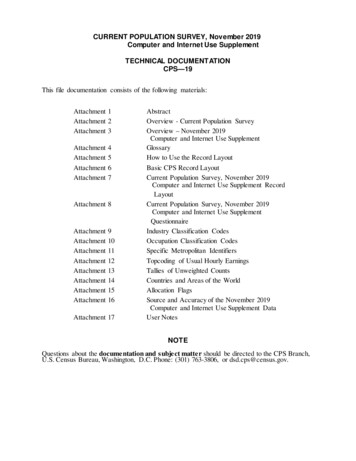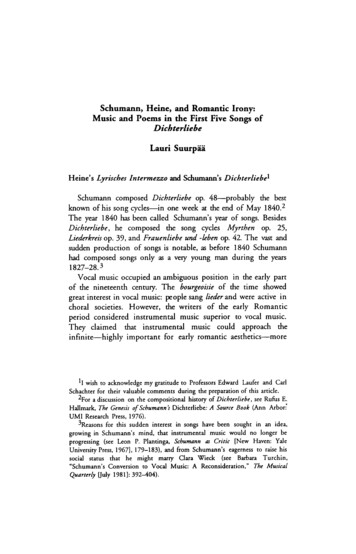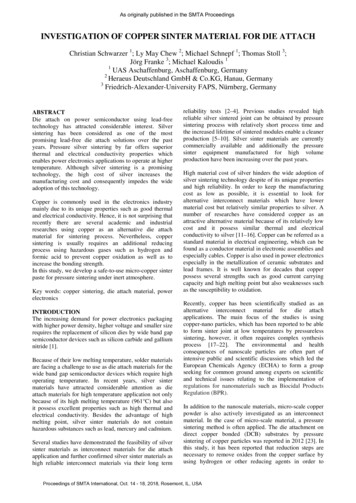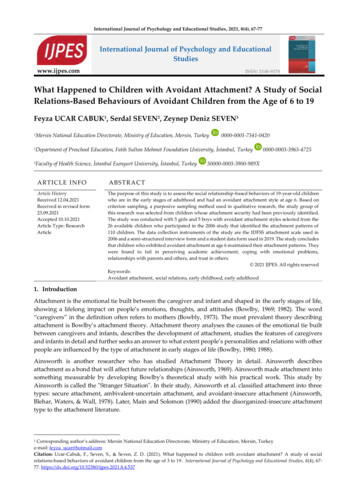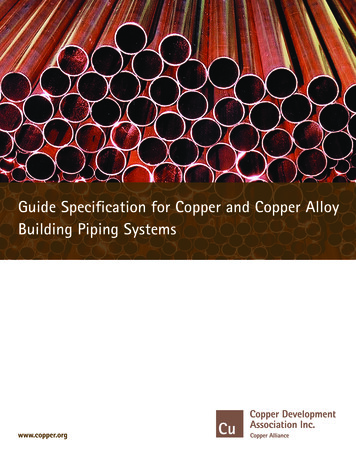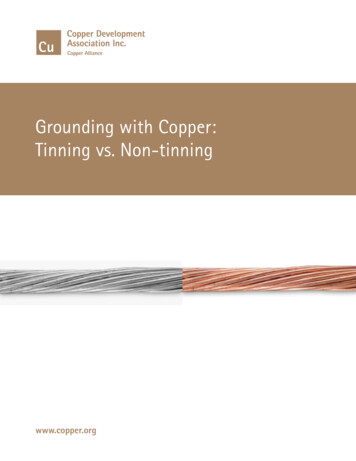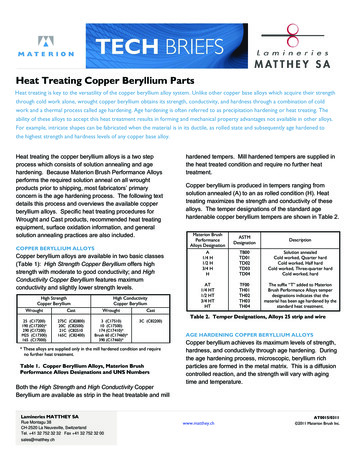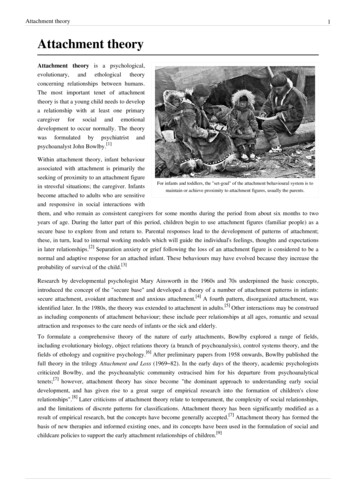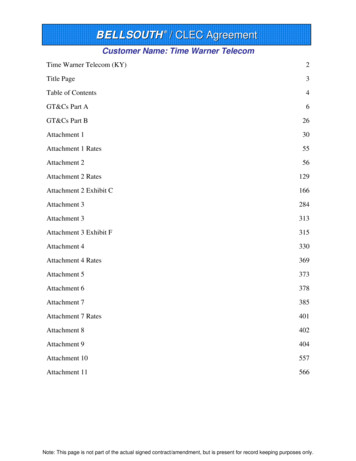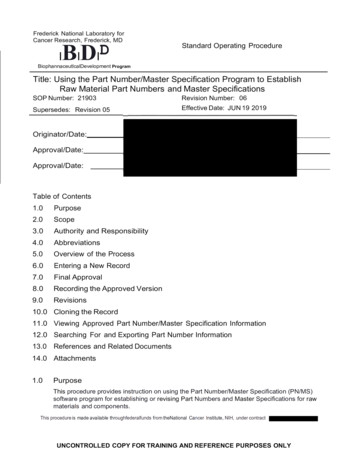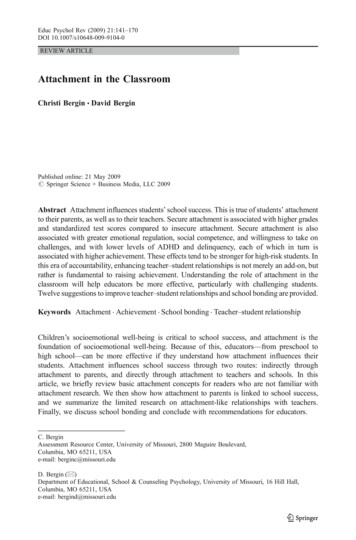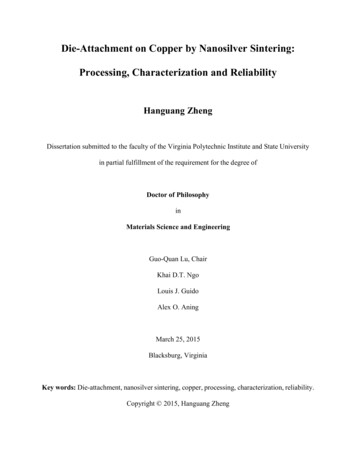
Transcription
Die-Attachment on Copper by Nanosilver Sintering:Processing, Characterization and ReliabilityHanguang ZhengDissertation submitted to the faculty of the Virginia Polytechnic Institute and State Universityin partial fulfillment of the requirement for the degree ofDoctor of PhilosophyinMaterials Science and EngineeringGuo-Quan Lu, ChairKhai D.T. NgoLouis J. GuidoAlex O. AningMarch 25, 2015Blacksburg, VirginiaKey words: Die-attachment, nanosilver sintering, copper, processing, characterization, reliability.Copyright 2015, Hanguang Zheng
Die-Attachment on Copper by Nanosilver Sintering:Processing, Characterization and ReliabilityHanguang ZhengAbstractDie-attachment, as the first level of electronics packaging, plays a key role for the overallperformance of the power electronics packages. Nanosilver sintering has becoming an emergingsolder-free, environmental friendly die-attach technology. Researchers have demonstrated thefeasibility of die-attachment on silver (Ag) or gold (Au) surfaces by pressure-less or low-pressure( 5 MPa) nanosilver sintering. This study extended the application of nanosilver sintering dieattach technique to copper (Cu) surface. The main challenge of nanosilver sintering on Cu is theformation of thick Cu oxide during processing, which may lead to weak joints. In this study,different processes were developed based on the die size: for small-area dice ( 5 5 mm2),different sintering atmospheres (e.g. forming gas) were applied to protect Cu surface fromoxidation; for large-area dice ( 5 5 mm2), a double-print, low-pressure ( 5 MPa) assistedsintering process was developed. For both processes, die-shear tests demonstrated die-shearstrength can reach 40 MPa.The effects of different sintering parameters of the processing were analyzed by differentmaterial characterization techniques. With forming gas as sintering atmosphere, not only Cusurface was protected from oxidation, but also the organics in the paste were degraded withnanosilver particles as catalyst. External pressure applied in the processing not only increased thedensity of sintered Ag, but also enhanced the contact area of sintered-Ag/Cu interface.Microstructure of Ag/Cu interface were characterized by transmission electron microscopy
(TEM). Characterization results indicate that Ag/Cu metallic bonds formed at the interface, whichverified the high die-shear strength of the die-attachment.Thermal performance of nanosilver sintered die-attachment on Cu was evaluated. A system wasdesigned and constructed for measuring both transient thermal impedance (Zth) and steady-statethermal resistance (Rth) of insulated gate bipolar transistor (IGBT) packages. The coefficient ofvariation (CV) of Zth measurement by the system was lower than 0.5%. Lead-free solder (SAC305)was applied in comparison of thermal performance with nanosilver paste. With same samplegeometry and heating power level, nanosilver sintered joints on Cu showed in average 12.6%lower Zth and 21.1% lower Rth than SAC305 soldered joints. Great thermal performances ofnanosilver sintering die-attachment on Cu were mainly due to the low thermal resistivity ofsintered-Ag and the good bonding quality.Both passive temperature cycling and active power cycling tests were conducted to evaluatethe reliability of nanosilver sintered joints on Cu. For passive temperature cycling tests (-40 – 125 C), the die-shear strengths of mechanical samples had no significant drop over 1000 cycles, andnanosilver sintered IGBT on Cu packages showed almost no change on Zth after 800 cycles. Foractive power cycling test (Tj 45 – 175 C), nanosilver sintered IGBT on Cu assembly had alifetime over 48,000 cycles. The failure point of the assembly was the detachment of thewirebonds. Great reliability performances of nanosilver sintered die-attachment on Cu weremainly due to the low mismatch of coefficient of thermal expansion (CTE) between sintered-Agand Cu. Meanwhile, low inter-diffusion rate between Ag and Cu prevented the interface from thereliability issue related to Kirkendall voids, which often took place in tin (Sn) -based solder joints.iii
AcknowledgementsIt is an honor for me to express my deepest gratitude to my advisor Dr. Guo-Quan Lu. Not onlyhis depth of knowledge, but also his rigorous research attitude inspired me through of all my Ph.Dstudy and will motivate me in the future. His precise attitude of conducting research and properways of handling problems set a great role model for me. His patience, encouragement, and greatsense of humor, have always been a powerful momentum for my advance through my graduatestudy. The experience he shared with me and the attitudes he showed to me have become a valuableresource for my entire life.I would like to thank my co-advisor, Dr. Khai D.T. Ngo, for his advising on my research overthe years. He discussed technical details with me in group meetings, and provided valuablesuggestions to help me passing through all the research challenges related to electrical engineering.I am very grateful to my other committee members, Dr. Louis J. Guido and Dr. Alex O. Aning,for serving on my committee and offering their valuable advices and help.I am also very grateful to Dr. Xu Chen for his unconditional guidance and support when Iinitiated my graduate study in Tianjin University. He introduced me to the exciting research areaof power electronics packaging.Special thank goes to the research scientist in our research group, Dr. Jesus N. Calata, for hisfriendship, kindness and sharing of his valuable skills and experiences. All of his extraordinaryhelp during my research are greatly appreciated.I am indebted to the Department of Materials Science and Engineering and Center for PowerElectronics Systems (CPES) at Virginia Tech for funding my research and providing researchfacilities through all these years.iv
I am grateful to all the colleagues whom I have been working with through all these years: Dr.David Berry, Dr. Kewei Xiao, Dr. Guangyin Lei, Dr. Xiao Cao, Dr. Yiying Yao, Dr. Zheng Chen,Dr. Tao Wang, Li Jiang, Yi Yan, Dr. Woochan Kim, Mudassar Khatib, Zhemin Zhang, Dr.Jongwon Shin, Dr. Kyozo Kanamoto, Akihisa Fukumoto, Seiya Yuki, Ying Wang, Di Xu, TaoTao, Shan Gao, Weizhen Sun, Jacob Monzel, Robert Acken, Ting Ge, Ye Fan, and many others,for their useful suggestions, friendship, encouragement and help.I also thank the electronic packaging research team in Tianjin University: Dr. Yunhui Mei, Dr.Lianyong Xu, Dr. Xin Li, and Dr. Gang Chen, for all the generous help and useful suggestions.I would like to thank Dr. Wenli Zhang, who provided guidance on my experimental work atpackaging lab of CPES. I also want to thank Stephen McCartney, Jay Tuggle and Dr. ChristopherWinkler at Nanoscale Characterization and Fabrication Laboratory (NCFL) of Institute for CriticalTechnology and Applied Science (ICTAS) for their great suggestions and technical support onthose materials characterization work.It has been a great pleasure to work in the MSE department and CPES. I would like toacknowledge all the administrative and management staff: Kim Grandstaff, Amy Hill, LeeAnnEllis, Cindy Perdue, David Gilham, Trish Rose, Teresa Shaw, Linda Long, and MarianneHawthorne. All my work would not come true without their countless help.My deepest gratitude belongs to my dearest girlfriend Yue Zhang. I feel so fortunate to be ableto share every moment, love and happiness with her.Finally, I am sincerely grateful to my parents. They are always unconditionally supporting meand encouraging me with their best wishes. Thanks for their endless affection and patience allthrough the years.v
Table of ContentsAbstract. iiAcknowledgements . ivTable of Contents . viList of Figures . xList of Tables . xvChapter 1 Introduction. 11.1 Overview of power electronics packaging . 11.1.1 Development trends of power electronics . 11.1.2 Challenges of power electronics packaging . 21.2 Review of die-attach technologies . 51.2.1 Traditional die-attach technologies . 51.2.2 State-of-the-art die-attach technologies . 91.3 Nanosilver sintering enabled die-attachment technology . 131.4 Motivation and objectives of research . 181.4.1 Motivation of the research . 181.4.2 Objectives of the research . 211.5 Organization of the dissertation . 22Chapter 2 Processing of nanosilver sintering die-attachment on copper surface . 232.1 Overview of nanosilver sintering on Cu surface . 232.1.1 Processing of nanosilver sintering on Ag and Au surfaces . 232.1.2 Challenges of nanosilver sintering on Cu surface . 25vi
2.2 Processing of nanosilver sintering on Cu: small-area dice. 262.2.1 Experimental procedures . 272.2.2 Results and discussion . 312.3 Processing of nanosilver sintering on Cu: large-area dice . 342.3.1 Experimental procedures . 342.3.2 Results and discussion . 372.4 Summary . 38Chapter 3 Characterization of nanosilver sintering die-attachment on copper surface . 403.1 Effects of sintering parameters on die-attachment . 403.1.1 Effects of different sintering atmospheres . 413.1.2 Effect of external pressure . 503.2 Bonding mechanisms of sintered-Ag/Cu interface . 533.2.1 Proposed bonding mechanisms . 543.2.2 TEM Sample fabrication . 563.2.3 TEM characterization of sintered-Ag/Cu interface . 613.3 Summary . 63Chapter 4 Thermal performance evaluation of nanosilver sintering die-attachment oncopper surface . 664.1 Introduction of thermal evaluation techniques . 674.1.1 Definition of thermal impedance (Zth) and thermal resistance (Rth) . 674.1.2 Measurement techniques overview . 694.2 System design and measurement procedures . 714.2.1 Design of the test system . 71vii
4.2.2 Zth measurement principle and procedures . 724.2.3 Rth measurement principle and procedures . 774.3 Measurement results and discussion . 794.3.1 Zth measurement results and discussion . 794.3.2 Rth measurement results and discussion . 814.4 Summary . 82Chapter 5 Reliability of nanosilver sintering die-attachment on copper surface . 845.1 Reliability testing systems . 845.1.1 Passive temperature cycling test system . 855.1.2 Active power cycling test system . 875.2 Passive temperature cycling test results and discussion . 895.2.1 Experimental procedure . 895.2.2 Test results and discussion . 915.3 Active power cycling test results and discussion . 985.3.1 Experimental procedures . 985.3.2 Test results and discussion . 1005.4 Summary . 102Chapter 6 Summary and future work . 1036.1 Summary of the research . 1036.2 Proposed future work . 1056.2.1 Simplification of the processing . 1056.2.2 Further testing of reliability. 1066.2.3 Technology demonstration . 106viii
References. 108Appendix ACircuit design details of the testing system for Zth, Rth measurements andpower cycling test . 125Appendix BLabVIEW codes for Zth, Rth measurements and power cycling test . 132Appendix CRelationship between Zth and die-shear strength of nanosilver sintered dieattachment . 140ix
List of FiguresFig. 1.1 Schematic of typical power device package. . 5Fig. 1.2 Suggested heating profile for 37Pb-63Sn eutectic solder [50]. . 8Fig. 1.3 Schematic representation of the low-temperature joining process: (a) deposition of theAg powder; (b) drying; (c) positioning of the device on the substrate; (d) sinteringunder pressure [83]. . 13Fig. 1.4 Six types of mass transport mechanisms of solid-state sintering [91]. 15Fig. 1.5 Basic formulation process of nanosilver paste. . 17Fig. 1.6 SEM image of nanosilver paste after sintering at 275 C. . 17Fig. 2.1 Typical heating profile for attaching small-area dice by sintering of nanosilver paste[92]. . 24Fig. 2.2 Schematic of nanosilver sintering process for large-area dice [100]. 25Fig. 2.3 TGA and DSC traces of nanosilver paste heated in air with rate 10 K/min [100]. . 27Fig. 2.4 Designed heating profile for pressure-less sintering nanosilver paste for attaching smallarea dice. . 28Fig. 2.5 Schematic diagram of applied substrate and small-area dice. . 28Fig. 2.6 Schematic of stencil printing process of nanosilver paste. . 29Fig. 2.7 Die-paste-substrate assemblies before sintering. . 30Fig. 2.8 Experimental setup for sintering of nanosilver paste in controlled atmospheres. . 30Fig. 2.9 Simplified schematic diagram of die-shear test. . 31Fig. 2.10 Die-shear strength of joints sintered at (a) 260 C and (b) 280 C. 32x
Fig. 2.11 Surface roughness measurements of different dice by profilometer. (Ra is the arithmeticaverage of the absolute values of heights). . 34Fig. 2.12 Schematic diagram of applied substrate and large-area dice. . 35Fig. 2.13 Flowchart of the modified double-print, pressure-assisted sintering process. . 37Fig. 2.14 Picture and schematic of fixture for die-shear test. . 37Fig. 2.15 Die-shear strength as a function of sintering pressure. . 38Fig. 3.1 Shear fractured surfaces of Si dice attached to DBC substrates after sintering in differentatmospheres. (a) 1% O2/N2. (b) Pure N2. (c) 4% H2/N2. 43Fig. 3.2 Optical microscopic color comparison between a fresh layer of nanosilver paste heatedto 280 C in pure N2 and 4% H2/N2. . 44Fig. 3.3 SEM images of the microstructures of nanosilver paste sintered at 280 C in differentatmospheres: (a) pure N2; (b) 1% O2/N2; (c) 4% H2/N2. 46Fig. 3.4 SEM images of the microstructures of nanosilver paste sintered at 400 C in controlledatmospheres: (a) pure N2; (b) 4% H2/N2. . 47Fig. 3.5 Simplified reaction formula between cellulose and H2 with nanosilver as catalyst. . 49Fig. 3.6 DSC comparison of binder combustion at different conditions (catalytic effect ofnanosilver). 49Fig. 3.7 Shear fractured surfaces of mechanical dice attached to DBC substrates sintered underdifferent sintering pressures: (a) 1 MPa, (b) 3 MPa, and (c) 5 MPa. . 51Fig. 3.8 SEM images of nanosilver paste sintered under different sintering pressures: (a) 0 MPa,(b) 1 MPa, (c) 3 MPa, and (d) 5 MPa. . 53Fig. 3.9 Ag-Cu binary equilibrium phase diagram. . 54xi
Fig. 3.10 Schematic illustration of the formation of “contact epitaxy” layers between nanosilverparities and Cu substrate [109]. . 55Fig. 3.11 Schematics of sample mounting and polishing procedures before FIB process: (a)sample mounting method with a tilted angle; (b) polishing process and area of interest. 57Fig. 3.12 TEM sample fabrication procedures: (a) top view of the sample before FIB processing;(b) deposition of a thin layer Pt; (c) revealing the area of interest by FIB; (d) samplelifting by an omniprobe; (e) thinning the sample to 100 nm thick by FIB. . 60Fig. 3.13 Bright-field TEM image of the sintered-Ag/Cu interface. . 62Fig. 3.14 EDS mapping of the sintered-Ag/Cu interface. . 62Fig. 3.15 HR-TEM images of the sintered-Ag/Cu interface. . 64Fig. 3.16 TEM image showing the C residue at sintered-Ag layer. 65Fig. 4.1 Overview of the custom-built Zth and Rth measurement system. 72Fig. 4.2 (a) Schematic for measuring linear relationship between Vge and Tj and (b) measureddata and best linear fit to data. . 74Fig. 4.3 Schematic diagram of Zth measurement circuit. . 75Fig. 4.4 (a) Typical waveform of Vge recorded by DAQ; (b) zoom-in waveform for Vge fcalculation. . 76Fig. 4.5 The press and chill plate applied for Rth measurement. . 78Fig. 4.6 Vge recording region for IGBT package for Rth measurement. . 78Fig. 4.7 Sample configuration of IGBT package. . 80Fig. 4.8 Zth measurement result for different die-attach materials. 80Fig. 4.9 Cumulative structure functions for calculating the Rth of an IGBT package. . 81xii
Fig. 5.1 Overview of temperature cycling system. . 86Fig. 5.2 Heating stage inside the chamber, with testing samples on top of it. . 86Fig. 5.3 Comparison between DAQ measured cycling temperature profile and JEDEC standardprofile. . 87Fig. 5.4 Schematic of the principle of power cycling test of IGBT assemblies. . 88Fig. 5.5 Screen shot of power cycling waveform of Tj in LabVIEW program. . 89Fig. 5.6 A typical sample of chips bonded on Cu lead-frames prepared for temperature cyclingtests. . 90Fig. 5.7 Changes of die-shear strength of the nanosilver sintered die-attachment on Cu duringtemperature cycling: (a) 3 3 mm2 Si dice; (b) 6 6 mm2 Al2O3 dice. . 92Fig. 5.8 2D X-ray images of cycled QFN packages. . 93Fig. 5.9 Average delamination ratio δ versus number of temperature cycles. . 94Fig. 5.10 Cross-sectional SEM image of QFN package after 1000 temperature cycles. . 96Fig. 5.11 Zth(40 ms) of IGBT packages versus number of temperature cycles. . 96Fig. 5.12 SEM image of Ag/Cu interface after shearing off of die. Sample has finished 1000cycles. 97Fig. 5.13 IGBT package applied for active power cycling test after encapsulation. . 99Fig. 5.14 Sample fixture for active power cycling test. . 99Fig. 5.15 Screen shot of active power cycling waveform of Tj (45 – 175 C). . 100Fig. 5.16 Power cycling test results of IGBT package: Zth(40 ms) versus number of cycles. . 101Fig. 5.17 2D X-ray image of the IGBT package after power cycling test (64,603 cycles). . 101Fig. A.1 Circuit design schematic of thermal characterization system. . 126Fig. A.2 Waveforms for logics of window comparator. . 129xiii
Fig. A.3 Circuit layout for the thermal testing system. . 130Fig. A.4 Design patterns for the print circuit board: (a) front side; (b) back side. . 131Fig. B.1 K-factor measurement.VI: (a) front panel; (b) block diagram. . 133Fig. B.2 K-factor linear curve fitting.VI: (a) front panel; (b) block diagram. . 134Fig. B.3 Heating power recording.VI: (a) front panel; (b) block diagram. 135Fig. B.4 Vge recording for Zth measurement.VI: (a) front panel; (b) block diagram. . 136Fig. B.5 Delta Vge calculation.VI: (a) front panel; (b) block diagram. . 137Fig. B.6 Vge recording for Rth-jc measurement.VI: (a) front panel; (b) block diagram. . 138Fig. B.7 Power cycling test.VI: (a) front panel; (b) block diagram. . 139Fig. C.1 Typical configuration of IGBT package for Zth measurement. . 142Fig. C.2 Different sintering processes for IGBT packages for building relation between Zth anddie-shear strength. . 142Fig. C.3 Zth measured with different heating pulse widths of all the IGBT packages as afunction of die-shear strength. . 144Fig. C.4 SEM images of nanosilver paste sintered with the same process as: (a) IGBT Package2; (b) IGBT Package-4; (c) IGBT Package-7; (d) IGBT Package-10. . 146xiv
List of TablesTable 1.1 The transport paths, sources and sinks of matter during sintering [91]. . 15Table 1.2 Properties comparison of different die-attach materials [94]. . 18Table 4.1 Reproducibility test results for Zth measurements. . 79Table 4.2 Reproducibility test results for Rth measurements. . 82Table A.1 Components used in circuit design of thermal testing system. . 126xv
Chapter 1Introduction1.1 Overview of power electronics packaging1.1.1 Development trends of power electronicsNowadays, environment conservation is becoming a pervasive concern. Carbonemissions from fossil fuels consumption generate greenhouse effect, which has become asignificant global crisis. Multiple government polices form United States and Europe werefunding researches related to alternative renewable energy sources [1-5]. Providing energyefficient solutions for various products is becoming increasingly important due to limitedenergy resources and climate changes. Energy generation and handling rely heavily uponpower conversion and storage technologies [6-9]. It therefore can be anticipated that powerelectronics conversion technologies will be increasingly developed and utilized more andmore in the applications of energy generation and handling.Over decades, the technology of power electronic semiconductors has made significantprogress, especially for increasing the power density [10-13]. The increase of powerdensity is mainly achieved by increasing the power device switching frequency, whichhelps reduce the sizes and weights of passive components (capacitors, inductors, andtransformers, etc.) [14]. The state-of-the-art silicon (Si) power devices are dominatingtoday’s power conversion systems. Typical switching speed of Si devices is below 50 KHz.It is rational to look for faster switches in power converters to further improve the power1
density [15, 16]. Wide bandgap (WBG) power semiconductor devices will ultimately beessential elements for power conversion due to the advanced system dynamiccharacteristics, overload capability, device ruggedness, and thermal and electricalperformance [17-25]. Take silicon carbide (SiC) for example, the material has a criticalelectric field of 2.0 MV/cm, which is one order of magnitude higher than Si. The blockingcapability of SiC power devices is much higher than Si devices, which allows much thinnerdie design and more highly doped drift layers, thus lower on-state resistance can beachieved. Meanwhile, the high ther
different processes were developed based on the die size: for small-area dice ( 5 5 mm2), different sintering atmospheres (e.g. forming gas) were applied to protect Cu surface from oxidation; for large-area dice ( 5 5 mm2), a double-print, low-pressure ( 5 MPa) assisted sintering process was developed.
